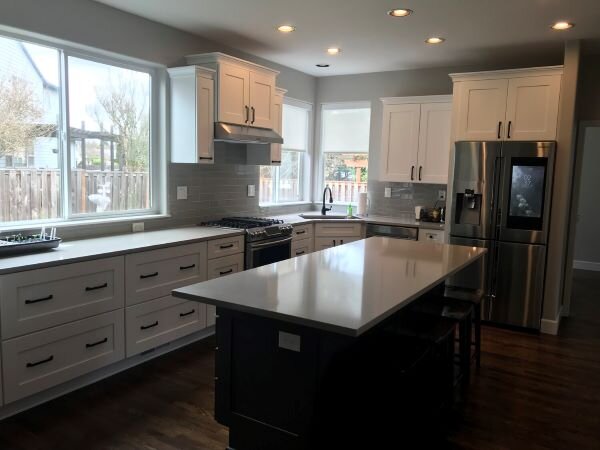My wife and I purchased our home in the spring of 2014. It was the first home Katherine, and I had bought that had not been previously lived in. Although our previous homes were not custom, we were able to choose the floor plan and individual cosmetic options before being built. This allowed us to somewhat meet our style and needs.
When we were planning on buying, we knew we were not going to have this option. We were very specific about the city we wanted to live in, which meant we would only be able to choose a home from what was available on the market. And, more importantly, those that would fit within our budget.
Because of this, we did not have much flexibility in house selections and therefore had to 'settle' for what was the best at that time. Although it was not perfect, it did have a home office, a 3 ½ car garage, and a beautiful patio cover. But the kitchen, which our family uses predominantly, had a terrible layout. We decided that we could live with this negative because of all the other positives.
After a few years, and as our children have gotten older, there began to be more bodies using the kitchen. More people cooking, preparing meals, and having friends over. At this point, a decision needed to be made: move or remodel.
Many decisions needed to be made to do what was best. What did we NEED now? What did we NEED down the road? And just as importantly, what did we WANT now and later?
I don’t know if you have ever seen or read the book If You Give a Mouse a Cookie, but this story fully resonates with me as I think about a kitchen remodel.
The number one problem with the kitchen was that the stovetop was placed in the island directly across from the fridge. Thus, someone could not cook at the same time another person wanted to open the refrigerator. We knew this needed to change, or the Dad (as I refer to myself) would go crazy.
Like the story of the mouse and the cookie, if we were going to move the stovetop, we would want a new range. If we were going to get a new range, we would need all new appliances. If we were going to get new appliances, we would need to move or change the island to work better. If we were going to change or move the island, it would require the hardwood floors to be worked on. And like the mouse, the cookie, and the milk, our remodel could have continued on and on.
As these discussions continued, we even had friends in the neighborhood with similar floor plans tell us they removed walls and completely changed the layout of their entire main floor to improve the function and aesthetics of their kitchens.
What were we to do?
We knew we needed to make a change, but we didn't know what and how. We had strong ideas of what we wanted, but we decided to hire a designer to help get their professional input because of our limited time and knowledge.
The designer we worked with was great. She listened to our needs. She asked us questions to clarify and understand what we were trying to accomplish. She brought up ideas and suggestions we had never thought of. We talked about costs and what we were and were not willing to spend. She wanted to be clear on what we were and were unwilling to have and spend when the project was fully complete.
Before starting the project, she had answered our questions about costs, options, and projected timeline. Once we felt good about the discussion, we gave her the green light to move forward.
Four months later, we were delighted with the outcome. Things weren't perfect, as we had hoped initially, but we couldn't have asked for a better kitchen given the parameters we had discussed.
Similar to a kitchen or home remodel, financial and retirement planning takes time and many discussions to get it right. For many, it may require a third-party CERTIFIED FINANCIAL PLANNING professional to help stimulate further discussion and give input on what is possible financially and not.
I firmly believe that true independent financial planning, like a kitchen remodel, does not have a cookie-cutter outcome. From my perspective, a successful outcome is unique to each and every person, just like our kitchen remodel was to us.










